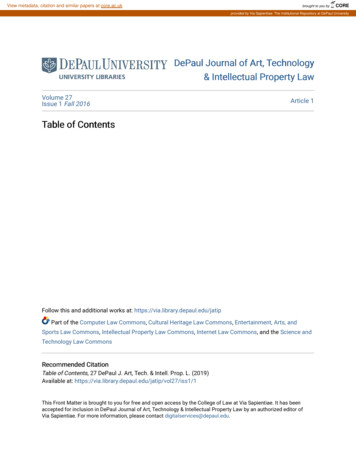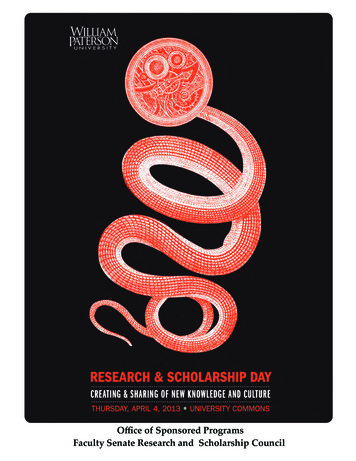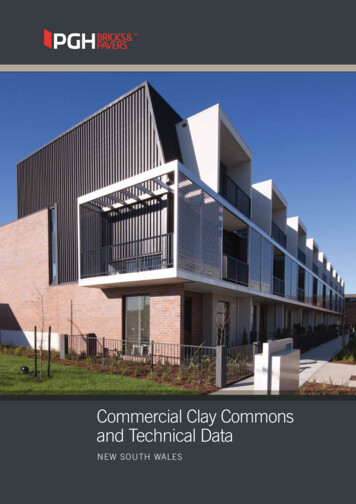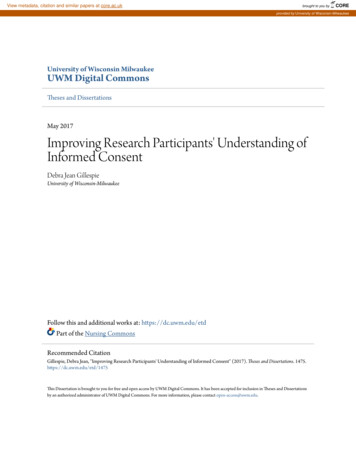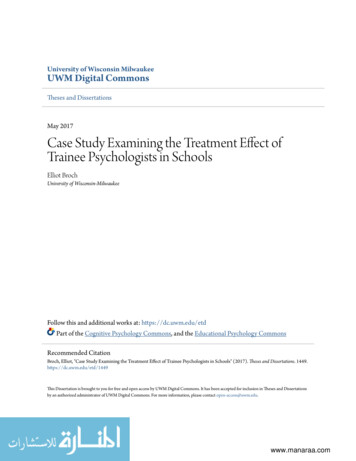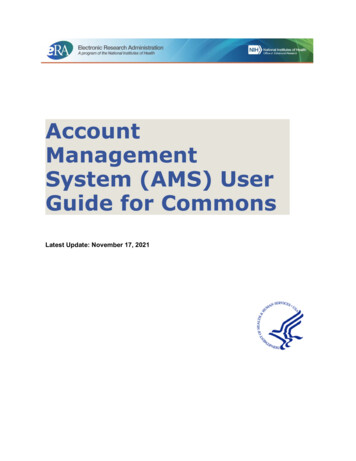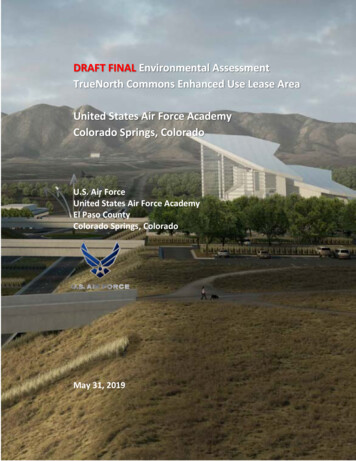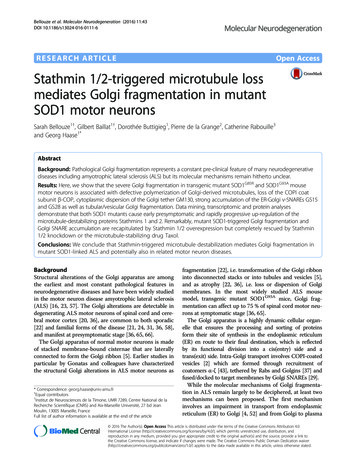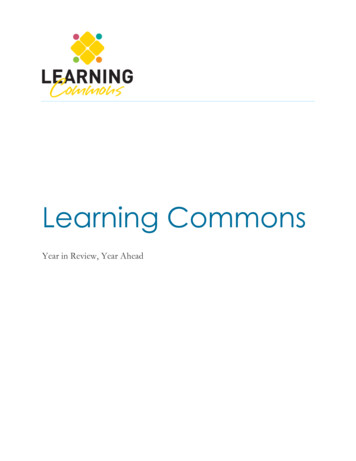
Transcription
Learning CommonsYear in Review, Year Ahead
Table of ContentsI.Service Desk . 3Staff TrainingNew ServicesStaffingStatisticsThe Year AheadII.Research Consultation Stations . 6StatisticsThe Year AheadIII.Programming . 7Programming ScheduleFocus GroupIssuesThe Year AheadIV.Tutoring . 9StatisticsThe Year AheadV.Solicitation Tables . 10StatisticsThe Year AheadVI.Course-Related Efforts . 10StatisticsVII. Outreach .11Student OutreachStatisticsFaculty OutreachThe Year AheadVIII. Food For Thought Cafe .11StatisticsThe Year AheadIX.Group Spaces. 12
StatisticsIssuesX.Technology . 13Computer Usage & Printing NumbersNotebook TransitionXI.Digital Signage . 14Campus Partner SignageLearning Commons SignageIssuesXII. Facility . 15Issues
Service DeskStaff TrainingService desk staff were offered weekly training sessions during the Fall 2013 semester and bi-weekly sessions in Spring2014. Before each semester, a weeklong training boot camp was arranged with multiple topics each day. The followingwere presented:Library Suma (data tracking software)Learning Commons Reserving groupspacesLearning Commons troubleshootingLibrary technologyVLC Media PlayerTumblr (Hannah Kane)Microfilm readersEvacuation PlansEmergency ProceduresCommunity BorrowersAleph user and item records Interlibrary LoanPoliciesSpringshare productsEndNote and RefWorksGovernment InformationReference CollectionElectronic ResourcesReferralsSpecial Collections and Iowa Woman’sArchive TourMap Collection TourMain Library Storage TourLearning Commons TourITS Print queue management (Les Neu)ITS Help Desk, including HawkID password reset and print refunds (Virginia Drake)SITA services and UI Capture (Megan Mathews)TILE (William Dawson)Campus Partners SWAT: Supplemental Instruction, Workshops, and Tutoring (Stephanie Preschel)De-escalation techniques (Alton Poole)Customer Service (Sean Hesler)Assistive Technology (Jim Stachowiak and Marti Slaughter)New Services In October 2013, began checking out PC and Mac notebook chargers. These were provided by theUI Student Government and have since become a very popular item for checkout.Library staff working overnight took over from ITS the cleaning of the computers.November 2013, the North entrance opens.HDMI, VGA, Ethernet cables, Dell mice, and wireless presentation slide advancers checked out tofacilitate usage of technology in group rooms and areas.In January 2014, began resetting HawkID passwords and refunding print jobs up to 1.00.LEARNING COMMONS - [SELECT DATE]3
Fall semester, student workers roved the first and second floors to provide point of need assistance.Spring semester, student workers were stationed at “Ask Me” booths to provide assistance awayfrom the service desk.Suma was implemented to track service desk transactions, roving transactions, and counts of whatusers are doing on the first and second floors. It has proven a useful tool to collect data to helpassess services and staffing levels.StaffingA Library Assistant III was hired to work 11:00pm to 8:00am, Sunday through Friday. They are responsible foranswering basic questions related to technology, library services, directional, campus, and refer users to other staff orservices. They also facilitate the resolution of facility and security issues and are assisted by two student workers. Afterthe initial person hired left, the replacement position’s hours were altered slightly and the overnight shift is now 9:00pmto 6:00am, Sunday through Friday. This change was made to accommodate having a full-time staff member at theservice desk during the busier times of the evening.Interlibrary Loan (ILL) staff were added to the daily schedule in January 2014. This additional staff provided moreflexibility and better coverage at the service desk.Librarians from the Research and Library Instruction (RLI) department are no longer scheduled at the service desk butare available for referrals by stationing themselves at the nearby research consultation workstations. They areoccasionally asked to fill in at the service desk, particularly during unforeseen scheduling problems or during busy times.The librarians are included in all training and communication activities.We hope to hire a library assistant that can be devoted to the service desk, much like the overnight position. This wouldallow RLI, ILL, and Circulation staff time for their regularly assigned duties away from the desk, as most are not able tokeep up with departmental tasks.Because of data from Suma and staff input, the staffing level at the service desk was reduced by one during the 8am to10am hours. We are currently working on adjusting our staffing levels for the Fall 2014 semester.StatisticsService Desk Transactions 54,588 check-outs8,382 interlibrary loan check-outs8,292 circulation questions8,049 directional questions4,342 technology questions5,100 notebook check-outs3,270 reference questions906 campus partner questionsLEARNING COMMONS - [SELECT DATE]Building Counts 967,696 people entered the buildingUser Activity 374,303 using a computer265,133 studying alone101,850 working in groups25,893 using smart phones11,594 waiting6,754 eating4,129 sleeping4
ReferenceQuestions3%Total sPartnerQuestions1%Check-outs59%InterlibraryLoan Checkouts9%Using WaitingSmart1%Phones3%Working inGroups13%User ActivityEating1%Studying Alone34%Roving Transactions, Fall 2013 42 directional questions36 technology questions22 reference questions10 circulation questions3 campus partner questionsLEARNING COMMONS - [SELECT DATE]Sleeping1%Using aComputer47%Ask Me Booths Transactions, Spring 2014 445 directional questions129 technology questions29 reference questions21 campus partner questions20 circulation questions5
Roving Vs. Ask Me BoothRoving TransactionsAsk Me Booth gyQuestions22 2910 artnerQuestionsThe Year AheadDuring the Fall 2013 semester student workers were assigned to rove around the first two floors of the library, makingthemselves available for questions. Data showed that patrons were not making use of this service so we switched tostationing students at a booth located at each entrance to answer technology and directional questions. Data showed thatthis service was heavily used during the first two weeks of classes and then dropped off significantly. This fall we will bescheduling library staff volunteers & student workers at each booth during the first two weeks of classes.Research Consultation StationsThe research consultation stations are exclusively used by librarians to offer research consultations and hold office hours.Librarians monitoring the library’s instant messaging service are also stationed at 1101 C, the station closest to theservice desk, to act as backup and to accept referrals from the desk.StatisticsConsultations by Type120100806040200LEARNING COMMONS - [SELECT DATE]EmailIn PersonPhone6
Consutations inConsultation Stations806040200In personPhoneEmailConsultations in Person806040200OfficeConsultationStationOtherThe Year AheadFeedback from the librarians using the research consultation stations indicated that the two stations are too closetogether and it can be awkward if both stations are in use. During the summer break the stations were reconfigured sothey are facing away from each other. This will give the librarians a better line of site to the service desk allowing forbetter referrals.ProgrammingAll of our programming for the year was held in one of the six group areas. During the Fall 2013 semester we scheduleda few programs in Area C, located in the Food for Thought Café, but feedback from presenters highlighted significantissues with the space. Many people didn’t see the space as a reservable area and often patrons would walk right through aprogram that was taking place. Presenters also felt that they were interrupting other patrons or that there was too muchgoing on in that area and they had to compete with high noise levels. We moved to Area D beginning Spring 2014. AreaD is located across from the Food for Thought Café and was preferred because of its location to a high traffic area, easeof way finding, and semi-enclosed environment.LEARNING COMMONS - [SELECT DATE]7
Programming ScheduleFall 2013Spring 2014Learning Commons ProgrammingLearning Commons Programming Finals Week ActivitiesExpress WorkshopsOn Iowa! Open HouseLate Night in the Learning CommonsOpen HouseLearning Commons Open HouseCampus Partner Programming Studio TalksFluxus Website Design Focus GroupAn Eating Disorder Awareness EventOn Purpose: A Conversation AboutAssignmentsVoting RegistrationGhosts in the StacksTRiO: GRE Test PrepSWAT Study GroupsBook History ExhibitSecuring Nonprofit Internships Finals Week ActivitiesExpress WorkshopsSocial Media Boot CampJuried Undergraduate Video ShowGrand OpeningCampus Partner Programming Brain Gain Academic FairCapture Iowa Photo ExhibitFinancial Aid ProgramShakespeare Live-Steam EventTRiO Book ClubPi DayArchives AliveSWAT/Financial Aid WorkshopsValentine’s Day ActivitiesSWAT study groupsVoting RegistrationStudio TalksFocus GroupAt the end of the Spring 2014 semester we gathered a small group of campus partners together to discuss the programsthat worked and didn’t work in the group areas and to come up with recommendations for the future. The groupfocused on Area D.The group felt that all of the programs offered during the last year worked well and that the only improvements neededwere logistical. They liked Area D because it was a high traffic location and is able to accommodate a wide number ofpeople in the space. The quality of the a/v equipment was a plus although the ambient noise (people walking by, printers,café) from the rest of the Learning Commons made it difficult to hear presenters, especially during class presentations,and to record presentations.The group felt that it could be difficult for students to find the group areas and liked the fact that we made use of thelarge monitors and print signage to help students find the space. They suggest we continue that practice in the future.Many students don’t recognize the group areas as reservable spaces and it was sometimes difficult to ask students toleave a group area when a program was about to take place. The group suggested we think about how presenters can“claim the space” including putting up a daily events list on the large monitor so people can see what’s going on that dayor setting out table tents.Another issue was making sure they had the correct technology for the event (notebook, cables, adaptor). It wassuggested that the Learning Commons provide for checkout a cart that is preloaded with a notebook, cables, slideadvancers and adaptors. The cart could also serve as a place for the notebook to sit during the presentation. It was alsoLEARNING COMMONS - [SELECT DATE]8
recommend that the Learning Commons make available for check out adaptors for patrons to use to hook their mac andmobile devices up to the monitors and mikes for program presenters to use.IssuesUndergraduate outreach & marketing has been a challenge for the Learning Commons. Because the space is located inthe Main Library, the identity of the Learning Commons is tightly tied in with that of the library. As a result, many of theprograms offered in the Learning Commons are either collaborations with the library or programming developed by thelibrary itself. This is advantageous in that it allows the Learning Commons to make use of various outreach channelsalready located within the library. It muddies the waters, however, in that it makes branding an issue and it is difficult todecide who should pay for what.The Learning Commons needs more direction on the types of programming it hosts. We’ve been asked to host largeacademic fairs and while that is an academic activity that would fit within the scope of the learning commons the size ofthe event is not. We have hosted a small academic fair, the Brain Gain, in January and it worked very well. It seems to bewithin the scope of the Learning Commons to provide programs and workshops that can stay within the capacity of thegroup areas. We also have requests to put on workshops and programs sponsored by student organizations. Theseevents can be considered both academic and social and it is difficult if they are within our scope or if they would bebetter suited at the IMU.The Year AheadWe plan to continue working on making our outreach efforts more streamlined and effective. By continuing to workwith campus partners and by increasing our partnerships with key faculty we hope to identify workshop topics that areof relevance to undergraduate student success and are directly connected to courses offered at the University.We will continue to offer much of our programming lineup from Spring 2014. The Digital Studio for Public Arts &Humanities will not be offering their Studio Talks series in the Learning Commons due to logistical issues. We willcontinue offering our Express Workshop series and we will host an open house again for On Iowa! We are working withMatt Gilchrist, from the Rhetoric Department to set up a program series called Show What You Know. This series willfeature students teaching short workshops on topics of interest. We are planning on partnering with HancherAuditorium on a project called Worth Fighting For to host a pop up museum featuring student projects based around artistin residence Liz Lerman. We are also partnering with the University Libraries to offer a series of digital badges toundergraduate students in order to increase student engagement with the University Libraries and the LearningCommons.TutoringThe Learning Commons did a trial run for the Statistics Tutoring Lab during the Fall 2013 semester. The lab reservedone group room for two weeks during midterms and again at finals. Their attendance went up 20%. As a result wedecided to continue stats tutoring for the entire spring semester. We also entered into partnerships with SWAT tutoringand the Writing Center.Statistics Statistics Lab Tutoring, South Lobby (1103, 1105, Area A) held 214 sessionsSWAT Tutoring (1113 Red) tutored 522 studentsWriting Center Satellite Station (Area D) held 72 appointmentsLEARNING COMMONS - [SELECT DATE]9
Monthly Tutoring g CenterAprilMayStats LabThe Year AheadWe have evaluated our partnerships with the three groups and have decided to continue offering tutoring sessions in theLearning Commons for the next academic year. All three groups were satisfied with the semester’s outcomes and we willnot be making any significant changes at this time.Solicitation TablesWe had many requests from student group and departments across campus to set up solicitation tables at the LearningCommons entry points. Solicitation tables are provided at the IMU so that organizations and departments may makecontact with students for the dissemination of information. While the operations team did not think it within the scopeof the Learning Commons’ mission to offer tabling sessions in these locations we did allow them to use the group areasfor tabling. We hoped this would help boost interest in and use of the group areas. These efforts were minimallysuccessful.StatisticsTotal Tabling Sessions: 9The Year AheadThe group areas aren’t conducive to tabling and to the expectations of student groups and departments who use thespaces for this purpose. The Learning Commons does not have the staff time to support tabling efforts in the space andit is not within our mission to do so. We plan to discontinue the use of tabling in the Learning Commons and will directinterested parties to the IMU in the future.Course-Related EffortsThe Learning Commons began hosting class presentations in the group areas for rhetoric classes during the Spring 2014semester. Instructor feedback was very positive and all instructors plan to continue the practice. Instructors alsoscheduled individual class sessions in the Learning Commons, reserving some group rooms for students to work ongroup projects. The space has also been used for one-shot library instruction classes and workshops. Class use of theLearning Commons has been very successful, especially when using the group areas.LEARNING COMMONS - [SELECT DATE]10
Statistics Total Class Presentations: 7Total Class Reservations: 20OutreachStudent OutreachThe Learning Commons has partnered with several different groups on campus to reach out to undergraduate students.We work very closely with the IMU Marketing & Design team to create marketing materials for the services, resourcesand activities offered in the Learning Commons. We’ve worked closely with the Office of Admissions to put the MainLibrary & Learning Commons as an essential destination on all campus tours.Statistics Total Tours - 17Faculty OutreachThe Student Instructional Technology Assistant group has agreed to give us some time during their TILE trainingsessions to give a short elevator speech on how faculty can use the Learning Commons to support their classroominitiatives. The Library Liaisons and the Center for Teaching have also been instrumental in helping to get the word outto faculty.The Year AheadThis coming year we plan on focusing our outreach efforts on the Rhetoric Department and all TILE-trained faculty.We also hope to continue developing our relationships with campus partners including the Library Liaisons and theOffice of Teaching, Learning & Technology. These two groups are key in reaching out to faculty. We plan on reachingout again to the Office of Admissions to provide tours for any new tour guides.Food For Thought CafeStatistics Total Transactions: 182,016Total TransactionsTotal Transactions3355122894298342446838941241468182Oct, 2013 Nov, 2013 Dec, 2013 Jan, 2014 Feb, 2014 Mar, 2014LEARNING COMMONS - [SELECT DATE]April,201411
The Year AheadBeginning August 2014 the Food for Thought Café will be going cashless. The only effect this may have on Librariesservices is the distribution of print keys, which guest users currently purchase at the café. Many guest users who usethese keys tend to pay cash.Group SpacesPrivate group rooms are by far the most reserved spaces, although, anecdotally, it seems that the group areas are beingused more and more and that the groups who do use the group areas tend to reuse them. Their experiences with theareas seem positive.Because the group areas were not being used as heavily as the group rooms we began using the group areas to bring inprogramming and course-based initiatives. We’ve also begun using the monitors in the group areas to promote eventshappening in the Learning Commons and, during finals week, we used the monitors to direct students to quiet studyareas. The areas most used were Area C, located within the Food for Thought Café, and Area D, located across from theFood for Thought Café. The areas least used were Area E and Area F located on the either side of the east entrance.Statistics Total Reservations: 28,539Total Online Reservations: 17,963Total Onsite Reservations: 10,576OnsiteReservations37%LEARNING COMMONS - [SELECT DATE]OnlineReservations63%12
Group Area Reservations, Fall 2013100%80%60%40%20%0%Aug-13Area ASep-13Area BArea COct-13Area DNov-13Area EDec-13Area FGroup Area Reservations, Spring 2014100%50%0%Jan-14Area AFeb-14Area BArea CMar-14Area DApr-14Area EMay-14Area FIssuesThe group room glass walls were originally supposed to be writable but due to installation error were not. Due to highdemand it was decided to fix the error and new writable film was installed on the glass walls during spring break 2014.The sliding doors to the group rooms were designed to come off of their tracks easily when the door is pushed open,which happens quite frequently. The Learning Spaces Operations Team considered and the rejected the idea of puttingup signs indicating how to open the door. The team suggests looking into finding a replacement handle that will betterindicate to the user how to open the door.TechnologyComputer Usage & Printing NumbersComputer use in the Learning Commons is very high. The north and east zones have desktop computers designed forstudents to camp out. The south zone has fewer computers than the other two zones and is made up of only expresscomputer stations that are designed for quick transactions. Even so, computer usage in the south zone is comparable toother ITCs on campus. Printing in the Learning Commons is also very high in all three zones. As a result we now offerprint refunds at the desk for up to 1.00.LEARNING COMMONS - [SELECT DATE]13
Public Computer Use - 5 Year Trend (hrs)250,000200,000150,000100,00050,000Spring 2010 Spring 2011 Spring 2012 Spring 2013 Spring 2014Main Library TotalMain Library (ex. LC)Learning Commons Usage (AY 2014)Hours/Comp/Week Pages PrintedMain Library Commons - East65.15511,967Main Library Commons - North56.56509,612Main Library Commons - South37.64376,163Main Library Laptops7.351,397,742Total PrintsNotebook TransitionThe service desk has 100 laptop computers available for checkout. Laptop checkout numbers are low and as a result ITSwill be repurposing 50 laptop computers this fall.Digital SignageThe Learning Commons digital signage, located at each entrance, displays a list of the events happening in the building,the bus schedule for the two bus stops located outside of the Madison St. Entrance, a section devoted to ads for services,resources and events for our campus partners, and one section for ITS, University Libraries and the Provost’s Office.Here’s a sample of some of the signs we posted throughout the year.Campus Partner Signage SERU SurveyCarver Scholarship, Office of FinancialAidEpxCon, Epx StudiosBlack History Month Events, Division ofStudent LifeLEARNING COMMONS - [SELECT DATE] RecycleMania, Office of SustainabilityFind Your Focus Info Session,Pomerantz Career CenterLGBTQ History Month, Division ofStudent Life14
Learning Commons Signage Lynda.com, ITSRick & Michael Mast Lecture, UniversityLibrariesFinals Week Events, Learning CommonsIntro to Environmental Science, ITS Help Desk Hours, ITSFood for Thought Café HoursExpress Workshop Series, LearningCommonsOpen Access Week, University LibrariesBrowZine, University LibrariesIssuesAxisTV is not an easy system to use and took quite a bit of time to learn. Periodically our screens have frozen andsomeone must go down the basement of the Main Library to unfreeze the screen.FacilityIssuesThere is still signage in the Learning Commons that is incorrect and some locations don’t even have signage. We arecurrently waiting for the signs to be replaced or fixed.Trash was a major issue when the Learning Commons opened. The space did not have enough trash receptacles orcustodial staff to keep the place clean. Things came to a head during a football weekend where trash was overflowing inthe learning commons. As a result trash receptacles were added and two more custodial staff were assigned to the library.The custodial staff has done a fantastic job keeping the facility clean, although, we had one other major trash incidentduring the weekend before spring finals. That was a scheduling error and is not likely to happen again.The interior doors at the Madison St. Entrance are extremely heavy. To fix this problem, the doors were switched frommanual entry to automatic. This transition has made the problem worse. Now the doors even heavier to open manually.They also open very slowly when opened automatically. A patron exiting the building must push on the door and thenstand there and wait for the door to slowly open.The Learning Commons is also experiencing issues with the temperatures in the group rooms and behind the servicedesk. The group rooms are usually too hot and the thermostats located in each group room don’t work leaving usersvery frustrated. The area behind the service desk is always very hot. The ITS Learning Spaces Team will be removingone shelving unit with 50 notebook computers which may help with the heat.LEARNING COMMONS - [SELECT DATE]15
Digital Signage. 14 Campus Partner Signage Learning Commons Signage Issues XII. Facility. 15 Issues. LEARNING COMMONS - [SELECT DATE] 3 Service Desk Staff Training Service desk staff were offered weekly training sessions during the Fall 2013 semester and bi-weekly sessions in Spring . Dell mice, and wireless presentation slide .
